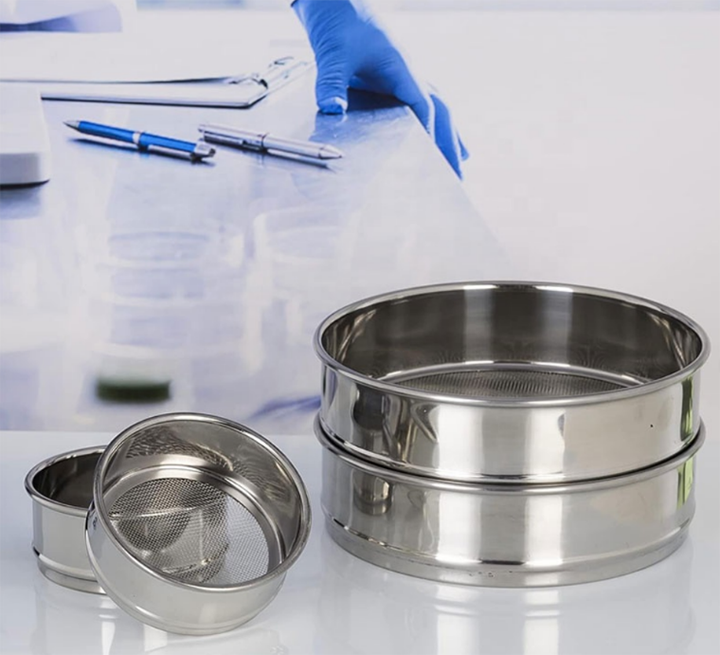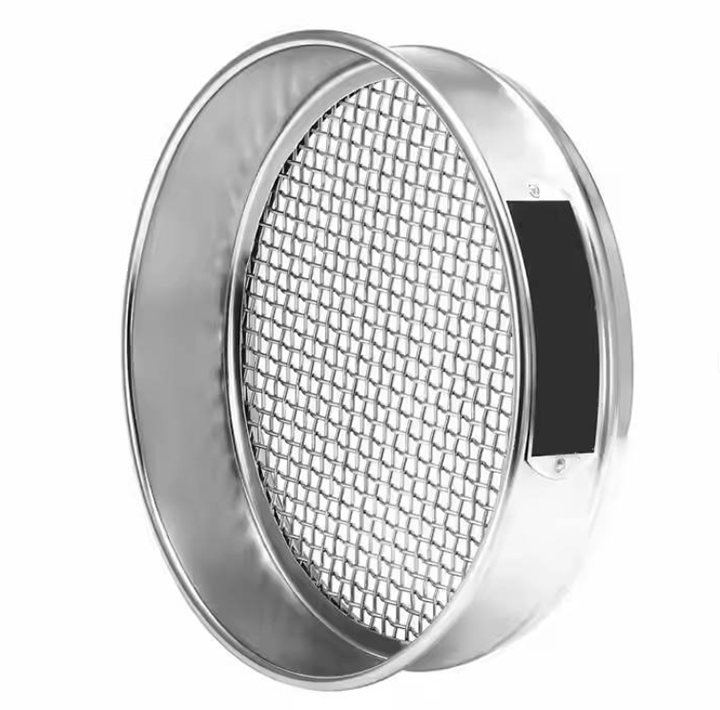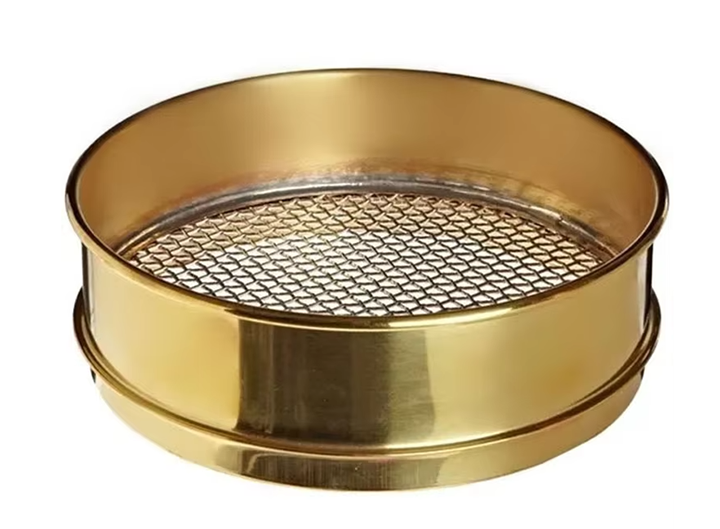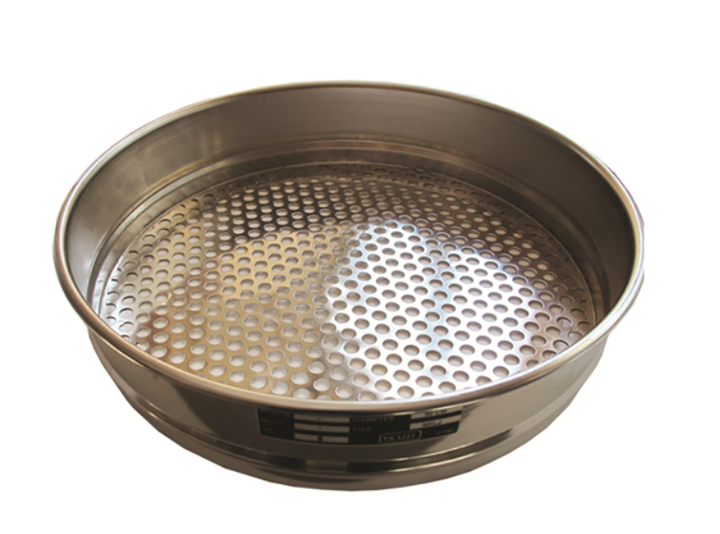Saturday November-22 2025 11:56:01
laboratory sieve with material are the cornerstone tools for particle size analysis. The aperture sizes of laboratory sieves typically range from 20 µm (635 mesh) to 125 mm, used for classifying materials across different particle size ranges. Manufacturing tolerances for the aperture size are strictly defined by standard systems, most commonly ISO 3310 and ASTM E11, with common aperture tolerances generally within ±2% to ±5%.

Sieve mesh materials include stainless steel wire mesh, brass mesh, galvanized steel wire mesh, and nickel mesh; stainless steel is the most commonly used due to its excellent corrosion resistance. Sieve frames are typically made of stainless steel, brass, or aluminum alloy; polymer sieve frames are chosen for some applications sensitive to chemical corrosion. Common sieve frame sizes are Φ200 mm, Φ100 mm, Φ300 mm, 8 inch, and 12 inch. The sieve design generally includes upper and lower pressure edge structures, equipped with rubber or silicone sealing rings to ensure no material leakage during sieving and to allow for a tight fit with a vibrating sieve machine.
The effective sieving capacity of a laboratory sieve with material depends on the sample properties and the sieve diameter. Generally, a Φ200 mm sieve can process 50–200 g of powder or granules at a time; for lightweight powders or high-density particles, the capacity can reach 1–2 kg. The time required to achieve effective separation is typically 1–10 minutes, depending on the material viscosity, particle size variation, and sieve aperture size.

After sieving, some flaky or fibrous materials, as well as very fine powders, may clog the sieve. Cleaning methods include tapping, soft brush cleaning, ultrasonic cleaning, or alcohol rinsing. For repeatability, multiple sieving results generally remain highly consistent, provided the sieve is not deformed or clogged and the vibration parameters are consistent. This type of sieve is usually used in conjunction with mechanical vibrating sieves, electromagnetic vibrating sieves, or sonic sieves, with electromagnetic and sonic sieves being more suitable for fine powders and easily clogged particles.
| 45 µm | 32 µm | 325 | ISO 3310-1 / ASTM E 11 |
| 50 µm | 36 µm | -- | ISO 3310-1 / ASTM E 11 |
| 63 µm | 45 µm | 230 | ISO 3310-1 / ASTM E 11 |
| 75 µm | 52 µm | 200 | ISO 3310-1 / ASTM E 11 |
| 80 µm | 56 µm | -- | ISO 3310-1 / ASTM E 11 |
| 90 µm | 63 µm | 170 | ISO 3310-1 / ASTM E 11 |
| 100 µm | 65 µm | -- | ISO 3310-1 / ASTM E 11 |
| 106 µm | 76 µm | 140 | ISO 3310-1 / ASTM E 11 |
| 125 µm | 90 µm | 120 | ISO 3310-1 / ASTM E 11 |
| 150 µm | 100 µm | 100 | ISO 3310-1 / ASTM E 11 |
| 160 µm | 100 µm | -- | ISO 3310-1 / ASTM E 11 |
| 180 µm | 125 µm | 80 | ISO 3310-1 / ASTM E 11 |
| 200 µm | 140 µm | -- | ISO 3310-1 / ASTM E 11 |
| 212 µm | 140 µm | 70 | ISO 3310-1 / ASTM E 11 |
| 250 µm | 160 µm | 60 | ISO 3310-1 / ASTM E 11 |
| 300 µm | 200 µm | 50 | ISO 3310-1 / ASTM E 11 |
| 315 µm | 200 µm | -- | ISO 3310-1 / ASTM E 11 |
| 355 µm | 225 µm | 45 | ISO 3310-1 / ASTM E 11 |
| 400 µm | 250 µm | -- | ISO 3310-1 / ASTM E 11 |
| 425 µm | 280 µm | 40 | ISO 3310-1 / ASTM E 11 |
| 500 µm | 300 µm | 35 | ISO 3310-1 / ASTM E 11 |
| 600 µm | 400 µm | 30 | ISO 3310-1 / ASTM E 11 |
| 630 µm | 400 µm | -- | ISO 3310-1 / ASTM E 11 |
| 710 µm | 450 µm | 25 | ISO 3310-1 / ASTM E 11 |
| 800 µm | 450 µm | -- | ISO 3310-1 / ASTM E 11 |
| 850 µm | 500 µm | 20 | ISO 3310-1 / ASTM E 11 |
| 900 µm | 500 µm | -- | ISO 3310-1 / ASTM E 11 |
| 1,00 mm | 0,560 mm | 18 | ISO 3310-1 / ASTM E 11 |
| 1,18 mm | 0,630 mm | 16 | ISO 3310-1 / ASTM E 11 |
| 1,25 mm | 0,630 mm | -- | ISO 3310-1 / ASTM E 11 |
| 1,40 mm | 0,710 mm | 14 | ISO 3310-1 / ASTM E 11 |
| 1,60 mm | 0,800 mm | -- | ISO 3310-1 / ASTM E 11 |
| 1,70 mm | 0,800 mm | 12 | ISO 3310-1 / ASTM E 11 |
| 2,00 mm | 0,900 mm | 10 | ISO 3310-1 / ASTM E 11 |
| 2,24 mm | 0,900 mm | -- | ISO 3310-1 / ASTM E 11 |
| 2,36 mm | 1,00 mm | 8 | ISO 3310-1 / ASTM E 11 |
| 2,50 mm | 1,00 mm | -- | ISO 3310-1 / ASTM E 11 |
| 2,80 mm | 1,12 mm | 7 | ISO 3310-1 / ASTM E 11 |
| 3,00 mm | 1,25 mm | -- | Toleranz: w ± 0,07 |
| 3,15 mm | 1,25 mm | -- | ISO 3310-1 / ASTM E 11 |
| 6,30 mm | 1,80 mm | ¼ in. | ISO 3310-1 / ASTM E 11 |
For general-purpose, wear-resistant, and corrosion-resistant materials, stainless steel sieves are recommended. For fine powders prone to static electricity, brass sieves or sieves with antistatic coatings can be considered. For materials requiring extremely high precision or handling highly abrasive materials, electroformed sieves should be used, as their smooth pore walls minimize clogging and wear. In acidic or special chemical environments, specific grades of corrosion-resistant stainless steel sieves are required.

If you want to separate a sample into three particle size grades, you will typically need four sieve apertures. A set of sieves should consist of the largest aperture at the top and the smallest aperture at the bottom. For a 50 g sample, Φ100 mm or Φ200 mm sieves can be used. For uniform distribution and higher resolution, Φ200 mm is recommended because it has a larger effective sieving area and prevents particle accumulation. To prevent dust from escaping during sieving, choose a sieve frame with a silicone sealing ring and use a metal or transparent top cover to effectively prevent dust spillage. For extremely fine powders, a closed mechanical vibrating screen or an electromagnetic vibrating screen can be used.
Laboratory sieve with materials include stainless steel, brass, and electroformed screens. When selecting a sieve, consider the acidity, alkalinity, corrosiveness, and static electricity content of the material to choose the appropriate sieve.
Stainless Steel Sieves: 304 stainless steel sieves have high mechanical strength and are suitable for most neutral materials, offering excellent cost-effectiveness; 316L stainless steel sieves offer better acid and alkali resistance and corrosion resistance, suitable for fine screening in the food, pharmaceutical, and chemical industries.

Brass Sieves: Brass sieves have good electrical conductivity and are suitable for materials where static electricity is undesirable. They are also suitable for screening conventional mineral or alloy powders, but have lower hardness and are prone to wear and oxidation. They are used for static-sensitive powders or in certain traditional processes in the food and pharmaceutical industries.

Nickel sieves or electroformed sieves: These offer extremely high aperture precision, mirror-smooth pore walls, and virtually no burrs. They are designed for high-precision research and quality control, such as calibration and analysis of abrasives, advanced ceramic powders, and printing toners, providing the most reliable data on extremely fine particle distribution.

As a factory with over 15 years of experience manufacturing test sieves, our sieves are made of materials conforming to ASTM and ISO standards. We offer full-height and half-height sieves, and in addition to commonly used metal sieves, we also provide nylon sieves. Our company covers a full range of equipment, from individual sieves to standard test sieve machines and ultrasonic test sieve machines, saving you time in the selection process.

laboratory sieve with material are suitable for solid materials in powder, granular, or fibrous form. They can be used for online testing points in production workshops and for classifying mixtures in R&D centers. Their performance is determined by aperture precision, sieve material, frame design, sealing structure, and compatibility with vibrating sieve equipment. Correct selection of aperture, tolerances, and standard systems can improve the repeatability and reliability of results. Different materials should be matched with appropriate screen materials. By reasonably configuring screen groups and screen diameters, accurate and reproducible particle size distribution can be obtained.
laboratory sieve with material
Laboratory sieves with materials include brass, stainless steel, or a brass frame with a stainless steel mesh, suitable for applications requiring precise particle analysis.......
Standard Test Sieve Sizes specification is the basis for ensuring the accuracy and comparability of screening results...
Stainless steel soil sieve is a basic tool used to classify and separate soil and similar granular materials...
material test sieve with sample
material test sieve with sample analyzes samples such as sand, quartz, fertilizer, and seeds to analyze particle size...
Dahan Machinery provides soil sieves of various specifications and models to meet the screening needs of different particle sizes and...
Nov 22, 2025
laboratory sieve with material
Laboratory sieves with materials include brass, stainless steel, or a brass frame with a stainless st...
Nov 22, 2025
laboratory sieve with material
Laboratory sieves with materials include brass, stainless steel, or a brass frame with a stainless st...
Nov 21, 2025
material screening test sieve consists of a robust stainless steel sieve frame and a wire mesh, with ...
Nov 20, 2025
vibration sieve for material testing
Vibration sieve for material testing is used for sample preparation of solid or bulk materials, enabl...
![]()
Then we look forward to hearing from you
Contact Us
Industrials
Yanjin county forest park gate to the west 1000 meters north road sitemap
